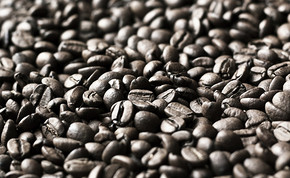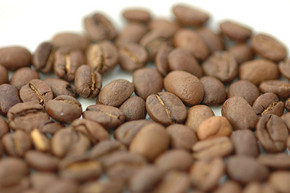According to the origin of Robusta coffee, does Robusta have any boutique coffee?
Follow the caf é (Wechat official account vdailycom) and found that Beautiful Cafe opened a small shop of its own.
Take a sip of 100% Robusta coffee and you will immediately know that it tastes astringent and terrible. It emits a smell called "Luobu", similar to the smell of burnt wheat, not only with a strong bitter taste, but also with a fishy smell and moldy smell. Therefore, it is not difficult to understand why it is used as an "increment" in canned coffee, instant coffee and poor-quality ordinary coffee.

Robusta was once rated as "worse than the lowest Brazilian Santos coffee". Although it can't be drunk directly, it will have a corresponding effect if mixed with Arabica. Although the sour and sweet taste is inferior to Arabica, its high concentration and strong bitterness are indispensable varieties of coffee for the above-mentioned industries. Moreover, Robusta also has strong disease resistance. It is highly resistant to leaf rust, the archenemy of coffee.
On the contrary, although Arabica has a good taste and aroma, it is weak in resistance to frost, diseases and insect pests. Airborne leaf rust once raged in India and Ceylon (now Sri Lanka), causing devastating disasters. This is why India and Ceylon have changed from big coffee producers to black tea kingdoms.
Brazil is also a major producer of Robusta.
In the past 40 years, I have never used Robusta. In the past, in some professional books written for cafes and western restaurants, I seriously suggested adding a certain percentage of Robusta to the production of mixed coffee. It not only increases the concentration and thickness of alcohol, but also suppresses costs, so as a "role in price adjustment", Robusta has always been regarded as a treasure.
Although I have never used Robusta, I think a mixture ratio of 10% to 15% should be the maximum limit if it is used for mixed coffee. If the limit is exceeded, it is easy to damage the taste and flavor. Perhaps it was because the refining technology at that time was not yet mature and sometimes produced excessive astringency and bitterness of Robusta.
Although it ushered in the "100% Arabica era" soon after, iced coffee and others still rely on Robusta. Because, if you do not use Robusta, it will not have the authentic color and bitter taste of coffee. Even so, I stick to 100% Arabica. To be honest, it bothers me when it comes to making iced coffee.
Robusta accounts for 30% to 40% of the world's coffee bean production, and its main producing countries are Vietnam, Indonesia and C ô te d'Ivoire. By the way, don't forget Brazil. In recent years, Brazil has been committed to the production of Robusta, which accounts for 30% of the total production. Unexpectedly, Brazil has become a major producer competing with Vietnam for the first place.
By the way, have you ever had Vietnamese coffee? It is called Vietnamese-style Olei coffee, thick and sweet, with a taste like licking coffee sugar. This coffee only uses Robusta, which is made in Vietnam, and a large amount of condensed milk is added to cover its strong bitterness. It is an imitation of Ole Coffee from the old Suzerain France.
In the words of Mr. Danbu, in countries such as France and Italy, people like deep-roasted coffee with milk because they are nostalgic for that colonial era, good or bad.
"countries such as Vietnam and C ô te d'Ivoire were once colonies of France, when coffee (mainly Robusta) was grown and served to countries such as France and Italy," Mr. Danbe said. If deep baking is used, the 'Luobu flavor' will be alleviated more or less. Therefore, the method that people think of is deep baking, which is called French baking and Italian baking. Mix it with milk to make Ole coffee or latte. Use milk to further soften the taste of Luobu. "
Robusta boutique coffee
In advance, Mr. Danbu and I have never belittled "Robusta" or regarded the disease-resistant variety of Robsta and Arabica as low quality, but its unique taste as "personality".
As a matter of fact, competitions and auctions are also held in countries such as India and Indonesia to select "boutique coffee" in the Robbins Tower. What is active on this stage is not Q (Quality Gradiy), but R (Robusta Gradiy, Robusta). Incidentally, Q Review is a coffee bean appraiser approved by the American Fine Coffee Association (SCAA), and its Robusta version is R Review.
Above, the two major varieties of coffee are described, and here, the Liberian species are also briefly introduced. It is sold only in some West African countries (Liberia) and has little circulation on the market. But historically, this variety has been juxtaposed with Robusta and Arabica, three of which are called the "three original species" of coffee.
Recently, Liberian coffee from the Philippines and Malaysia began to appear on the market in Japan. There are two opinions of pros and cons in taste evaluation, which can be said to be a kind of personality coffee.
But did you know that Arabica comes from Robusta? According to genetic analysis, it is known that Arabica is a variety produced by accidental hybridization between Robsta and Okinoides. Although the words are not pleasant to hear, it is indeed "a Phoenix comes out of a raven's nest".
Important Notice :
前街咖啡 FrontStreet Coffee has moved to new addredd:
FrontStreet Coffee Address: 315,Donghua East Road,GuangZhou
Tel:020 38364473
- Prev

How to distinguish Arabica beans from robusta beans
Following Cafe (official Wechat account vdailycom) found that it is not difficult to tell Arabica beans and Robbota beans from Arabica beans by opening a small shop of its own. You can easily tell the difference between Arabica beans and Robbota beans by their appearance. The former is slightly oval and slender, the central line (Center Cut) is S-shaped and greenish, while the latter is round and fat, and the central line is almost straight.
- Next

What's the taste of Robusta?
Follow Kaipai (Wechat official account vdailycom) and find that Fairview Cafe opens a small shop of its own. What's the difference between Arabica Tibica and Bourbon? Mr. Danbu believes that there is little difference between the two in terms of genetics and composition. The main reason is that the composition and structure of raw beans are different, which will have a great impact on the flavor of baked beans. However, the difference
Related
- Detailed explanation of Jadeite planting Land in Panamanian Jadeite Manor introduction to the grading system of Jadeite competitive bidding, Red bid, Green bid and Rose Summer
- Story of Coffee planting in Brenka region of Costa Rica Stonehenge Manor anaerobic heavy honey treatment of flavor mouth
- What's on the barrel of Blue Mountain Coffee beans?
- Can American coffee also pull flowers? How to use hot American style to pull out a good-looking pattern?
- Can you make a cold extract with coffee beans? What is the right proportion for cold-extracted coffee formula?
- Indonesian PWN Gold Mandrine Coffee Origin Features Flavor How to Chong? Mandolin coffee is American.
- A brief introduction to the flavor characteristics of Brazilian yellow bourbon coffee beans
- What is the effect of different water quality on the flavor of cold-extracted coffee? What kind of water is best for brewing coffee?
- Why do you think of Rose Summer whenever you mention Panamanian coffee?
- Introduction to the characteristics of authentic blue mountain coffee bean producing areas? What is the CIB Coffee Authority in Jamaica?

